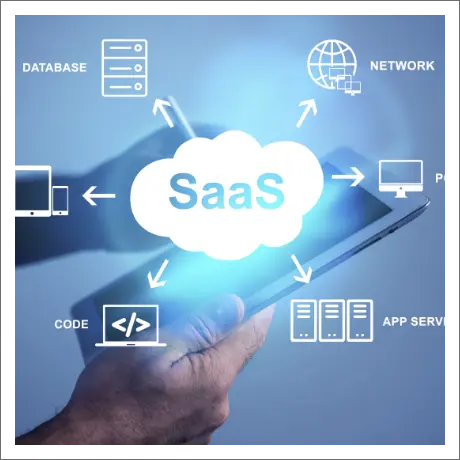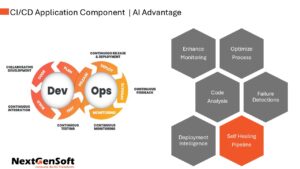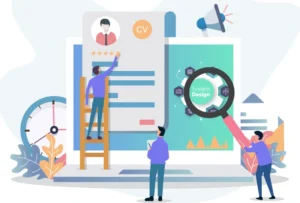Maximize Developer Productivity with DevSecOps Consulting
Many organizations embracing DevOps frequently disregard joining security into their workflows, making noteworthy vulnerabilities. Without a proactive DevSecOps approach, groups experience challenges such as undetected code flaws, administrative non-compliance, and increased information breach risks. This oversight frequently leads to costly fixes, deployment delays, and reduced client trust. A need for computerized security testing assistance presents gaps within the CI/CD pipeline, preventing early danger identification and remediation.
Integrating DevSecOps into your workflow is pivotal to overcoming these impediments. Embrace best practices like shifting security left within the improvement lifecycle, robotizing security tests inside CI/CD pipelines, and utilizing apparatuses for vulnerability scanning and risk location. Cultivate collaboration between improvement, operations, and security groups to develop a culture of shared duty. Utilizing Infrastructure as Code (IaC) with inserted security arrangements and actualizing nonstop observing guarantees compliance and vigorous security.
NextGenSoft specializes in helping businesses with DevSecOps services, making custom-fitted DevSecOps implementation plans and DevSecOps implementation roadmaps to meet their particular needs. From distinguishing vulnerabilities in existing workflows to building secure CI/CD pipelines, our experts deliver end-to-end arrangements for secure software delivery. We offer a comprehensive DevSecOps service including automated security integration, vulnerability management, and compliance observing, guaranteeing your applications are resilient and meet industry guidelines. Partner with NextGenSoft to attain quicker, more secure organizations with decreased hazard and upgraded versatility.

Why Security is Essential in DevSecOps?

Evolving Threat Landscape
Cyberattacks and data breaches are on the rise, and are growing in sophistication.
Applications, and especially cloud-native ones, are vulnerable to many attack surfaces, such as third-party dependencies and configurations.
Proactive security measures can prevent these vulnerabilities from being exploited and causing severe financial and reputational damage.
Speed of DevOps Increases Risk
DevOps is speed oriented, and fast development, testing, and deployment cycles result in afterthought about security which can result in gaps in addressing critical vulnerabilities.
DevSecOps embeds security by design, not by the end.
Compliance and Regulations
From there, businesses with industry-specific regulations like GDPR, HIPAA, or PCI-DSS must follow suit.
DevSecOps integrates compliance checks into the continuous integration and continuous delivery (CI/CD) pipeline, ensuring compliance without a slow-down of workflows.
Cost of Fixing Security Issues
Most importantly, vulnerabilities detected in production can take much longer and be more expensive to remediate than those detected during development.
DevSecOps Implementation Stratgey: When Everything Starts in the Left Lane DevSecOps moves security left, starting identification and remediation earlier in the development cycles
Continuous Monitoring and Resilience
All traditional security measures rely on onetime audits and leave gaps in between to let potential attacks slip through.
The DevSecOps outsourcing services enhances the resilience of system by ensuring regular monitoring, automated scanning, and real-time threat detection.
Integration with Modern Architectures
Modern development practices—microservices, containers, serverless—broaden potential attack surfaces.
DevSecOps strategy helps to ensure security policies and controls are enforced in a consistent manner across these dynamic enclaves.
Cultural Shift Towards Shared Responsibility
In DevSecOps, developers, operations, and security teams work together to create a culture.
But security becomes a shared responsibility, leading to better accountability and less friction.
Challenges in DevSecOps
However, it is crucial to establish an efficienct and versatile DevSecOps strategy, but this may affect the seamless implementation and workflow of the organization.
Fragmented Toolchains
Challenge: However, the complexity of deployment tools such as native DevOps pipelines provide a number of challenges when it comes to implementing security: Solution: From an infrastructure perspective, look to take on a holistic DevSecOps platform or make sure your lines of tools fit together through API calls.
Balancing Speed and Security
Challenge: While implementing DevOps is about rapid delivery, that often comes at the expense of comprehensive security checks. Solution: Increase automation in security testing to ensure that it doesn’t slow down CI/CD pipelines.
Lack of Security Expertise
Challenge: This could be a challenge, since developers and operations teams often lack knowledge about security to understand how best to mitigate vulnerabilities. Solution: Train teams to upgrade skills and create a centralized system for shared responsibility security.
Insufficient Automation
Challenge: Conventional security forms cannot coordinate the speed of DevOps services, causing delays or inadequately security checks. Solution: Modern Tools such as Snyk or SonarQube can automate monotonous errands, like scanning for vulnerabilities or checking for compliance.
Resistance to Cultural Change
Challenge: Security is typically treated as its own silo in contrast, which inhibits cross-collaboration among development, operations, and security. Solution: Encourage a DevSecOps strategy, whereby security is part of the process from Day 1 and responsibilities are shared among teams.
Managing Legacy Systems
Challenge: Manual security forms cannot keep up with the speed of DevOps execution, resulting in security checks being postponed or skipped totally. Solution: Execute security steadily with modernization of legacy systems.
Dynamic and Complex Architectures
Challenge: Cloud-native models, microservices, and holders presently include more parts, thus more complexity. Solution: The arrangement for this may be joining Kubernetes security scanners, runtime security observing, and benefit work policies.
Cost and Resource Constraints
Challenge: Organizations often find it difficult to allocate the necessary resources — tools, training, manpower, etc. — for implementing DevSecOps. Solution: Invest in security solutions that are scalable and open-source-based, while tracking ROI by highlighting reduced vulnerabilities and breaches.
Ensuring Compliance Across Pipelines
Challenge: Rapidly changing CI/CD pipelines and compliance standards (e.g., GDPR, HIPAA, PCI DSS) can make it difficult to keep pace with evolving security requirements. Solution: Solutions for Pipeline Building, SecurityProblem: Application Security Compliance.
Handling Third-Party Risks
Challenge: Using third-party dependencies & libraries can introduce vulnerabilities from outside your own codebase. Solution: Use dependency management tools to regularly identify and patch vulnerable components.
Security Practices for DevOps
Shift Security Left in the SDLC
By shifting security left, security is not tacked onto the completion of the SDLC, but rather implemented at all points on the development pipeline, beginning with the design and coding phases of the SDLC — identifying and remediating vulnerabilities while they are still inexpensive to fix rather than later in production — something that can be executed by root cause analysis in the planning stage and static application security testing (SAST) tools for the early scanning of code.
Automate Security Testing
Automation of security testing means integrating tools like Snyk, OWASP ZAP or SonarQube in CI/CD pipelines to perform vulnerability scans for code, dependencies and containers in an automated manner; where you are reducing the manual effort, speeding the deployment cycles and ensuring that every build is subjected to thorough and consistent security testing.
Implement Role-Based Access Control (RBAC)
Role-Based Access Control (RBAC): RBAC is a policy mechanism that restricts access to systems, resources, and environments based on user roles, ensuring that users have a minimum level of access with the least level of privilege necessary. The use of tools like Kubernetes or cloud providers with RBAC policy enables the segregation of access to minimize the risk of insider threats or unauthorized access (data theft) in the environment, making it necessary for permission reviews and regular access checks.
Secure the CI/CD Pipeline
CI/CD pipeline security is to ensure that all stages of the software development process, from development to production, are free from tampering, unauthorized access, and insecure code deployments, and an optimal option for securing CI/CD pipelines is 2FA for those accessing the pipeline and secrets management tools to store API keys and credentials securely.
Monitor and Log Activity Continuously
Continuous monitoring and logging is the process of detection and response to threats in real-time, using tools to centralize logging and monitoring such as the ELK Stack, Splunk, and Datadog, as well as monitoring and alerting to suspicious activities—all of which helps alert an organization on anomalies and creates an audit trail, which can be used for forensic analysis.
Secure Dependencies and Open-Source Components
The second step is to secure dependencies and open-source components where it is important to regularly check third-party vulnerabilities through libraries and dependencies in order to protect the application from an attack in the supply chain; you can use tools like Dependabot, WhiteSource, or Nexus IQ, and you need to make sure that all libraries are updated with security patches while implementing DevSecOps.
Adopt Infrastructure as Code (IaC) Security
Infrastructure as Code (IaC) Security: They secure the configuration files for IaC tools such as terraform, CloudFormation, as well as Ansible, preventing misconfigurations and implementing consistent security policies by scanning IaC templates for vulnerabilities with tools like Checkov or Bridgecrew, as well as applying least privilege and broker encryption policies in configurations.
Ensure Compliance with Regulations
Compliance is a major regulatory requirement; as a result, you must ensure that your DevOps workflows align with industry standards and regulatory requirements such as GDPR, HIPAA, or PCI-DSS to avoid penalties, build trust, and maintain a competitive edge, and this can be done by automating the relevant compliance checks in the pipelines, with policy-as-code frameworks enforcing the business needs to meet regulatory compliance.
Container and Kubernetes Security
Cloud-Native/CaaS (Container as a Service) — Container & Kubernetes Security, primarily focuses on ensuring risk minimization for cloud-native applications within container and orchestration platforms through tools such as Aqua Security or Falco to secure the container runtime and also through in-Kubernetes policies around pod security and segmentation of network types.
Use Zero Trust Security Model
A Zero Trust Security Model, which validates all users and devices that access systems irrespective of their location, minimizes risk from insider threats and unauthorized access, can be adopted by deploying identity verification tools, such as Okta or Azure AD, and implementing continuous authentication and monitoring across all network activity.
Conduct Regular Security Audits and Penetration Testing
Perform periodic security audits and penetration testing to ensure that you identify gaps in your systems that are unprotected and that your defenses keep up with evolving attack patterns — This can help you still validate your systems through third-party penetration testing at regular intervals and conduct red-team-testing for threat simulation from a sort of attacker standpoint.
Regular Security Training and Awareness
One key aspect of this stage is educating and training the team by teaching developers, operations and security on secure coding and DevSecOps implementation so that human errors can be reduced through a collaborative approach to security; this can be done through regular workshops and hands-on training sessions and encouraging participation in a bug bounty program or ethical hacking challenges.
Why NextGenSoft?
End-to-End Expertise
Partner with NextGenSoft, a global digital transformation company, and leverage our multi-cloud engineers’ abilities. As a trusted IT solutions provider, we build up secure inter-cloud networks, map native cloud services, and make vendor-agnostic methodologies to maximize esteem and minimize dangers.
Delivery Excellence
We rethink delivery excellence with optimized program lifecycles. From development to deployment, our digital transformation services and solutions ensure reliable, high-quality releases that enhance client satisfaction, as showcased in our Case Studies.
Flexible Hiring Model
NextGenSoft’s adaptable contracting models give access to talented IT service providers custom-fitted to your needs. Scale easily with agile assets for DevOps, guaranteeing consistent collaboration and venture victory.
Transparent Actions
Our commitment to straightforwardness builds belief and cultivates cooperation. As a leading digital transformation company in India, we ensure adjusted objectives, open communication, and compelling collaboration for shared success.
Security Tools
- SAST Tools
- DAST Tools
- SCA Tools
- IaC Security Tools
- SIEM Tools
- Secret Management Tools
- Pipeline Security Tools
- EDR Tools
- Threat Intelligence Tools
- CSPM Tools
- IAM Tools
Static Application Security Testing (SAST) Tools
Dynamic Application Security Testing (DAST) Tools
OWASP ZAP (Zed Attack Proxy)
Burp Suite
Acunetix
Software Composition Analysis (SCA) Tools
Snyk
WhiteSource
OSS Index
IaC Security Tools
Terraform
Checkov
TFSec
Security Information and Event Management (SIEM) Tools
Splunk
Elastic Stack (ELK)
Sumo Logic
Secret Management Tools
Vault (HashiCorp)
AWS Secrets Manager
Azure Key Valut
CyberArk Conjur
Google Cloud Secret Manager
Pipeline Security Tools
OWASP Dependency-Check
JFrog Xray
SonarQube
Snyk
Trivy
KICS
EDR (Endpoint Detection and Response) Tools
Carbon Black
Microsoft Defender for Endpoint
Trend Micro Apex One
Threat Intelligence Tools
MISP
ThreatConnect
Recorded Future
CSPM (Cloud Security Posture Management) Tools
Prisma Cloud (Palo Alto Networks)
Wiz
Lacework
Bridgecrew
IAM (Identity and Access Management) Tools
Okta
AWS IAM
Auth0
Azure Active Directory (Azure AD)
Security Implementation Strategy

Assess and Audit Security
First, have well-defined goals with measurable metrics (like faster time-to-market / higher code quality percentages, etc.
Generate Report & Solution
You will gather team feedback and you can analyze what is solution that you have right now (tools, workflow, bottlenecks, manual steps, etc), Assess Processes.
Shift Left Security
Pick tools that align with your objectives, budget, and team's proficiency, but weigh factors like ease of use, scaling potential, integration capabilities, and community support.
Implement Continuous Security
Pipeline Visualization Create a visual representation of your pipeline, defining the stages (build/test/deploy) and dependencies. The pipeline can then be validated with a pilot run after building massive automation.
Monitor & Improve
Always go for the continual assessment and the fine-tuning of the pipeline to update the whole workflow.
Enhance Security with other DevOps Services

CI/CD Services
Automate software delivery with streamlined CI/CD pipelines, empowering quicker releases, moved forward quality, and diminished manual effort.

Cloud DevOps Services
Go near to the cloud-native DevOps to automate deployment, optimize infrastructure, and maintain high availability on AWS, Azure, and GCP.

Containerization Services
Generate and manage microservices, using Kubernetes, Docker and container orchestration for higher productivity.

DevOps Assessment
Professional Level – Assess and enhance your DevOps maturity through the recommendations for automation and optimizing workflows with tactical insights.
Frequently Asked Questions
-
What is DevSecOps implementation?
In every phase of the DevOps lifecycle, DevSecOps implementation ensures security. It emphasizes automation, collaboration, and ceaseless security practices to build secure applications effectively. A strong DevSecOps execution strategy ensures proactive risk moderation. -
What are the best practices for implementing DevSecOps?
For ceaseless enhancement, the best practices for implementing DevSecOps include: Integrating security tools into CI/CD pipelines Managing regular code reviews Automating danger checking Cultivating team collaboration Aligning with a detailed DevSecOps implementation guide -
How is DevSecOps implemented in an organization?
DevSecOps implemented in an organization ensures security to DevOps practice. To ensure seamless security integration into tasks, embedding security tools, security checks in the CI/CD process, training groups on DevSecOps practices, and developing a clear DevSecOps execution strategy assists. -
How long does it take to implement DevSecOps?
Depending on the project's complexity, experience, and consistent practice, the time for DevSecOps varies from weeks to months. Leveraging DevSecOps consulting services accelerates the process with master guidance and a tailored DevSecOps strategy. -
Why is DevSecOps important?
Security is integral for sure is not an afterthought throughout development, thus DevSecOps ensures certainty. DevSecOps reduces vulnerabilities, improves compliance, and fastens delivery. A solid DevSecOps strategy enhances strength and trust in digital systems. -
What is a DevSecOps implementation strategy?
DevSecOps implementation strategy provides a roadmap for integrating security into the DevOps lifecycle. With the help of cutting-edge tools, training, and automation to create safe, effective, and collaborative processes while utilizing DevSecOps managed services ensure building secure software. -
How is DevSecOps implemented?
DevSecOps implemented is assisted with integrating security tools, automating vulnerability assessments, creating a security-focused culture, and leveraging DevSecOps outsourcing services to ensure robust, streamlined implementation across the organization.
Contact us

Submit Your Inquiry

Detailed Proposal

Collaborate and Plan





































